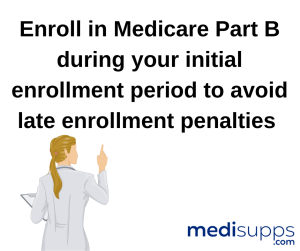
by Russell Noga | Updated September 6th, 2023
 Navigating the world of healthcare coverage can be an overwhelming experience, especially when it comes to understanding the ins and outs of Medicare Part B. But fear not, dear reader, for we are here to guide you through this complex maze of outpatient care, costs, and eligibility.
Navigating the world of healthcare coverage can be an overwhelming experience, especially when it comes to understanding the ins and outs of Medicare Part B. But fear not, dear reader, for we are here to guide you through this complex maze of outpatient care, costs, and eligibility.
By the end of this article, you’ll have a comprehensive understanding of Medicare Part B and be well-equipped to make informed decisions about your healthcare coverage needs.
Short Summary
- Medicare Part B provides coverage for medically necessary outpatient services and preventive care.
- Costs associated with Medicare Part B include monthly premiums, annual deductibles, and coinsurance payments.
- Individuals should consider other coverage options such as Medicare Advantage Plans or Prescription Drug Coverage (Part D) to supplement traditional coverage based on their individual needs.
 Medicare Part B Overview
Medicare Part B Overview
Medicare Part B is your key to unlocking a world of outpatient care, including doctor visits, lab tests, and medical equipment. While Medicare Part A primarily focuses on hospital stays and skilled nursing facilities, Part B ensures you have access to critical outpatient services necessary for maintaining your health and well-being.
Of course, Medicare Part B comes with its own set of costs, such as monthly premiums, annual deductibles, and coinsurance payments. But don’t worry, we’ll delve deeper into these expenses later on.
For now, it’s essential to understand that there are several enrollment options available for Medicare Part B, including the Initial Enrollment Period (IEP), Special Enrollment Period (SEP), and General Enrollment Period (GEP).
Coverage under Medicare Part B
When it comes to Medicare Part B coverage, you can expect a wide array of medically necessary outpatient services and preventive care, such as vaccinations and screenings. This Medicare coverage ensures that you have access to essential health services. Some examples of covered services include:
- Visits to healthcare providers
- X-rays
- Stitches
- Casts
- Durable medical equipment like CPAP machines and wheelchairs
- Ambulance services
- Mental health services
The importance of Medicare Part B cannot be overstated, as it provides vital coverage for both medically necessary outpatient services and preventive care. With Part B in your corner, you can rest assured that you’ll have access to the care you need to maintain optimum health.
Exclusions from Medicare Part B
While Medicare Part B covers a wide range of services, it’s important to note that certain services are excluded from coverage. These exclusions include routine eye exams, cosmetic surgery, and other services that may require additional insurance or out-of-pocket payments.
Some of the specific services and items not covered by Medicare Part B include:
- Long-term care
- Most dental care
- Eye exams for prescription glasses
- Dentures
- Massage therapy
- Nonprescription medicines
- Vitamins and supplements
- Certain preventive examinations
These services and items, including preventive services, are excluded due to their lack of medical necessity and may require additional coverage or out-of-pocket payments.
Discover Plans & Rates
Enter Zip Code
 Costs Associated with Medicare Part B
Costs Associated with Medicare Part B
Now that we’ve covered the basics of Medicare Part B coverage, let’s dive into the costs associated with this essential healthcare plan. Medicare Part B expenses include monthly premiums, annual deductibles, and coinsurance payments for services that are covered.
The Medicare Part B deductible’s prce updates annually. For 2025, the Part B deductible is $257.
Lastly, the coinsurance payments for Medicare Part B are typically 20% of the Medicare-approved amount for the majority of services.
Monthly Premiums
Medicare Part B monthly premiums are calculated based on income, with individuals with higher incomes paying a greater amount. Beneficiaries whose 2021 income was more than $97,000 (individual return) or $194,000 (joint return) have to pay premiums ranging from $230.80 to $560.50. This amount varies depending on their income.
It’s important to note that the monthly premium for Medicare Part B is not a one-size-fits-all figure. Instead, it’s tailored to your specific financial situation, ensuring that you pay an amount that’s fair and reflective of your income.
Deductibles and Coinsurance
In addition to monthly premiums, Medicare Part B also includes an annual deductible and coinsurance payments for covered services. In 2025, the annual deductible for Medicare Part B is $257.
After meeting this deductible, beneficiaries are typically responsible for a 20% coinsurance payment for most medically necessary services covered under Medicare Part B.
While these costs can be a burden for some, supplemental insurance like Medicare Supplement Insurance, also known as Medigap, can help cover the deductibles and coinsurance costs associated with Medicare Part B.
By carefully reviewing your options and considering the addition of supplemental insurance, you can better manage your out-of-pocket expenses and ensure access to the care you need.
Enrollment in Medicare Part B
Now that you have a grasp on the coverage and costs associated with Medicare Part B, it’s time to explore the enrollment options available and sign up for Part B. As mentioned earlier, there are three enrollment periods for Medicare Part B: Initial Enrollment Period (IEP), Special Enrollment Period (SEP), and General Enrollment Period (GEP).
Each of these enrollment periods comes with specific eligibility requirements, and it’s crucial to understand when and how you can enroll to avoid potential penalties. To help you navigate the enrollment process, we’ll delve deeper into each of these enrollment periods and their requirements.
Initial Enrollment Period (IEP)
The Initial Enrollment Period is a critical time for enrolling in Medicare Part B. This 7-month window commences either on an individual’s 65th birthday or after 24 months of disability benefits have been received. Enrolling during the IEP ensures that you can avoid any late enrollment penalties and secure the coverage you need when you need it.
It’s essential to be aware of your IEP and take advantage of this opportunity to enroll in Medicare Part B. Failure to do so can result in higher monthly premiums for the duration of your enrollment.
Special Enrollment Period (SEP)
In certain circumstances, individuals may qualify for a Special Enrollment Period (SEP), allowing them to enroll in Medicare Part B without incurring a late enrollment penalty.
Not enrolling in Part B or premium Part A when initially eligible can be due to being covered under a group health plan based on an individual’s own or a spouse’s current employment. It is also possible if it is based on a family member’s current employment if they are disabled. This period is available to those individuals.
Examples of circumstances that may qualify an individual for SEP include loss of employer coverage, termination of a group health plan, and end of COBRA continuation coverage.
It’s important to be aware of any circumstances that may qualify you for a SEP and act accordingly to secure your Medicare Part B coverage.
General Enrollment Period (GEP)
For those who miss their Initial Enrollment Period and don’t qualify for a Special Enrollment Period, there’s still hope. The General Enrollment Period takes place annually from January to March and allows individuals to enroll in Medicare Part B.
However, it’s important to note that coverage for those who enroll during the GEP begins the month following enrollment.
Comparing Medicare Part B with Other Options
While Medicare Part B provides a solid foundation for outpatient care, it’s worth exploring alternative or additional coverage options, such as Medicare Advantage and Part D plans. These plans offer unique benefits and can complement or even replace traditional Medicare Part B coverage, depending on your specific healthcare needs.
Medicare Advantage Plans
 Medicare Advantage Plans are private health insurance plans approved by Medicare, providing coverage for both Part A and Part B benefits. These plans often offer additional benefits, such as:
Medicare Advantage Plans are private health insurance plans approved by Medicare, providing coverage for both Part A and Part B benefits. These plans often offer additional benefits, such as:
- Vision coverage
- Hearing coverage
- Dental coverage
- Prescription drug coverage
Additionally, Medicare Advantage Plans, offered by private insurance companies, have an annual limit on out-of-pocket costs for medical services, offering a layer of financial protection through medical insurance, compared to Original Medicare, which may have higher out-of-pocket costs. These plans can be a valuable addition to one’s social security benefits.
Enrolling in a Medicare Advantage Plan can be done during your Initial Enrollment Period (IEP), Special Enrollment Period (SEP), or General Enrollment Period (GEP).
By comparing your Medicare Part B coverage with the benefits of a Medicare Advantage Plan, you can make a more informed decision about your healthcare coverage needs.
Prescription Drug Coverage (Part D)
Medicare Part D is a valuable addition to your healthcare coverage toolkit, offering prescription drug coverage through private insurance plans. These plans feature varying premiums, copays, and deductibles, allowing you to choose the coverage that best suits your prescription medication needs.
While Medicare Part B does cover some prescription drugs, Part D plans can provide more comprehensive coverage and help manage your out-of-pocket costs for medications.
By carefully comparing your Medicare Part B coverage with the benefits of a Part D plan, you can optimize your healthcare coverage and ensure you have access to the medications you need.
 Navigating Out-of-Pocket Costs
Navigating Out-of-Pocket Costs
Out-of-pocket costs can be a significant concern for individuals enrolled in Medicare Part B. However, by carefully reviewing your coverage options and considering supplemental insurance, such as Medigap policies, you can better manage these expenses.
When selecting or altering your coverage, ensure that the plan encompasses the services you require. Acquire knowledge of the costs to facilitate better planning for out-of-pocket expenses.
Medicare Supplement plans also referred to as Medigap plans, may aid in covering some of the out-of-pocket costs that Medicare Part B does not cover. By being proactive and staying informed, you can navigate the world of out-of-pocket costs with confidence and ease.
Late Enrollment Penalties
Enrolling in Medicare Part B during your initial enrollment period is crucial to avoid the dreaded late enrollment penalties. These penalties can be financially burdensome, as they result in a 10% increase in your monthly premium for each 12-month period you delay enrollment.
If you miss your Initial Enrollment Period and don’t qualify for a Special Enrollment Period, you can still enroll during the General Enrollment Period, but it’s important to be aware of the potential penalties.
By understanding the consequences of late enrollment and acting accordingly, you can avoid unnecessary financial burdens and ensure you have access to the healthcare coverage you need.
Medicare Part B and End Stage Renal Disease (ESRD)
Individuals with End Stage Renal Disease (ESRD) have unique enrollment requirements and options for Medicare Part B coverage. Navigating these requirements can be challenging, but with the proper knowledge and resources, you can ensure access to vital outpatient services provided by Medicare Part B.
To enroll in Medicare Part B as an ESRD patient, you’ll need to complete Form CMS-43. It’s essential to understand the specific enrollment options available to you as an individual with ESRD and plan accordingly to secure your Medicare Part B coverage.
Health Care Providers and Medicare Part B
Healthcare providers play a crucial role in ensuring access to necessary outpatient services for beneficiaries of Medicare Part B. By providing information, guidance, and ongoing support in managing healthcare needs, they serve as invaluable resources in navigating the complexities of Medicare Part B coverage.
When seeking a healthcare provider who accepts Medicare Part B, it’s essential to verify their participation in the program before enrolling.
Engaging with a provider who accepts Medicare Part B can facilitate access to appropriate treatments and interventions, as well as provide invaluable information and advice on coverage, costs, and eligibility.
Summary
In conclusion, understanding the intricacies of Medicare Part B is essential for ensuring access to the outpatient services and preventive care necessary for maintaining optimal health.
By familiarizing yourself with the coverage, costs, and enrollment options, you can make informed decisions about your healthcare coverage needs and confidently navigate the world of Medicare Part B.
Remember, knowledge is power, and with the information provided in this blog post, you are well-equipped to take control of your healthcare journey.

Compare Plans & Rates
Enter Zip Code
Frequently Asked Questions
What is Medicare Part B, and what does it cover?
Medicare Part B is a component of the federal health insurance program for people aged 65 and older. It covers medically necessary services like doctor’s visits, outpatient care, preventive services, and some medical equipment.
Who is eligible for Medicare Part B?
Most people aged 65 and older are eligible for Medicare Part B, but it’s also available to younger individuals with certain disabilities and those with end-stage renal disease.
Can I delay enrolling in Medicare Part B if I have other health coverage?
If you have other creditable health coverage, like through your employer or union, you can delay enrolling in Part B without penalty. However, you should enroll when your other coverage ends to avoid a late enrollment penalty.
What are the costs associated with Medicare Part B?
The costs for Part B include a monthly premium, an annual deductible, and coinsurance or copayments. The premium amount can vary based on your income.
How is the Medicare Part B premium calculated?
Medicare Part B premiums are based on your annual income. Higher earners may pay higher premiums through an income-related monthly adjustment amount (IRMAA).
Does Medicare Part B cover prescription drugs?
Medicare Part B primarily covers medical services and equipment, not prescription drugs. For drug coverage, you may need to enroll in a standalone Medicare Part D plan.
Are there any preventive services covered by Medicare Part B?
Yes, Medicare Part B covers a range of preventive services, including vaccinations, screenings, and annual wellness visits at no cost to the beneficiary.
Can I change my Medicare Part B coverage during the annual Open Enrollment period?
Yes, during the Medicare Open Enrollment period, you can switch from Original Medicare to a Medicare Advantage plan or vice versa. You can also change your Part B coverage during this time.
Are there any penalties for late enrollment in Medicare Part B?
Yes, if you don’t enroll in Medicare Part B when you’re first eligible and you don’t have other creditable coverage, you may incur a late enrollment penalty, which can result in higher premiums.
How do I apply for Medicare Part B?
You can apply for Medicare Part B by contacting the Social Security Administration either online, by phone, or by visiting a local Social Security office. It’s advisable to enroll during your Initial



